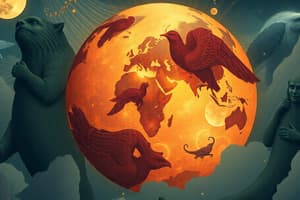Podcast
Questions and Answers
A meteoroid becomes a meteor when it is in the Earth's atmosphere.
A meteoroid becomes a meteor when it is in the Earth's atmosphere.
True (A)
The phase of water known as vapor is considered a solid.
The phase of water known as vapor is considered a solid.
False (B)
The presence of carbon dioxide in the atmosphere contributes to cooling the planet's temperature.
The presence of carbon dioxide in the atmosphere contributes to cooling the planet's temperature.
False (B)
Photoautotrophic organisms utilize chemical energy from the soil to produce food.
Photoautotrophic organisms utilize chemical energy from the soil to produce food.
The atmosphere is primarily composed of oxygen and ozone, providing essential gases for life.
The atmosphere is primarily composed of oxygen and ozone, providing essential gases for life.
The Stratosphere contains the Ozone layer which absorbs UV radiation and resides between 14.5 and 50 km from Earth.
The Stratosphere contains the Ozone layer which absorbs UV radiation and resides between 14.5 and 50 km from Earth.
The Thermosphere is characterized by extremely low temperatures and minimal satellite activity due to its thin atmosphere.
The Thermosphere is characterized by extremely low temperatures and minimal satellite activity due to its thin atmosphere.
The Earth's crust is the densest layer of the geosphere, primarily composed of iron and nickel.
The Earth's crust is the densest layer of the geosphere, primarily composed of iron and nickel.
The Mesosphere extends from 50 to 85 km above Earth's surface and is where temperature can reach as low as -90 degrees Celsius.
The Mesosphere extends from 50 to 85 km above Earth's surface and is where temperature can reach as low as -90 degrees Celsius.
Approximately 70-80% of the entire atmospheric mass resides in the Stratosphere.
Approximately 70-80% of the entire atmospheric mass resides in the Stratosphere.
Flashcards are hidden until you start studying
Study Notes
Temperature
- Influences molecular motion and organism activity.
- Low temperatures slow chemical reactions, while high temperatures accelerate them.
- Earth's temperature is optimal for supporting life.
Meteors
- Meteoroids: Objects floating in space.
- Meteors: Meteoroids burning up in the atmosphere.
- Meteorites: Meteors that have landed on Earth's surface.
Water
- Essential for biological processes; lack of water disrupts life-sustaining reactions.
- Exists in three phases: solid (ice), liquid (water), and gas (water vapor).
Atmosphere
- Provides insulation and protection from solar radiation and meteor impacts.
- Greenhouse gases (CO2, CH4) trap heat, preventing Earth's freezing.
- Ozone layer (O3) shields against harmful UV radiation.
- Supplies critical gases (oxygen, nitrogen, carbon dioxide) for life.
- Thickness influenced by Earth's size and sun distance; maintained by gravity.
Energy
- Solar energy supports life on Earth.
- Photoautotrophic organisms (plants, photosynthetic bacteria) use sunlight for food.
- Chemosynthetic organisms harness chemical energy for biochemical processes.
Nutrients
- Essential for the development and structure of organisms.
- Nutrient deficiency hampers the synthesis of biological molecules.
Magnetic Field
- Protects Earth from solar winds, coronal mass ejections, and energetic particles.
The 4 Subsystems of Earth
Atmosphere
- Composed of gases from Greek "atmos" (gas) and "sphaira" (globe).
- 78% Nitrogen, 20% Oxygen, 0.9% Argon, 0.1% others.
- Contains five layers: Troposphere, Stratosphere, Mesosphere, Thermosphere, Exosphere.
Troposphere
- Extends up to 14.5 km; home to life forms and most weather events.
- Contains 70-80% of the atmosphere’s mass.
Stratosphere
- Ranges from 14.5 to 50 km; contains the ozone layer.
- Holds 20-30% of the atmosphere’s mass; ozone absorbs UV radiation.
Mesosphere
- Extends from 50 to 85 km; experiences cold temperatures (-90°C).
- Protects Earth from space debris through combustion of meteors.
Thermosphere
- Ranges from 85 to 600 km; characterizes large temperature changes.
- Houses the ionosphere, where UV and X-rays ionize atoms.
- Contains many satellites.
Exosphere
- Extends from 600 to 10,000 km; considered the edge of space.
- Lacks a clear boundary between atmosphere and outer space.
Geosphere
- "Geo" in Greek means ground; includes compositional and dynamics layers.
Compositional Layers
- Crust: Thin layer of continents and ocean floor (oceanic crust: 5-10 km thick; continental crust: 15-70 km thick); made of silicate materials (Silicon and Aluminium).
- Mantle: Denser than crust, primarily silicate rocks (Iron and Magnesium), about 3000 km thick; temperature increases with depth.
- Core: 3400 km radius, composed of Iron and Nickel; source of Earth's internal heat.
Dynamics Layers
- Lithosphere: Crust plus upper mantle; consists of tectonic plates, solid rocks.
- Asthenosphere: Malleable, semi-liquid zone in the upper mantle beneath the lithosphere.
- Mesosphere: Extremely dense and molten layer.
- Outer Core: Molten region surrounding the inner core.
- Inner Core: Solid center of the Earth.
Hydrosphere
- "Hydro" in Greek means water; encompasses all water on Earth's surface: lakes, oceans, rivers, wetlands, icecaps, soil, rock layers, and clouds.
- Comprises 97.5% saltwater and 2.5% freshwater.
Studying That Suits You
Use AI to generate personalized quizzes and flashcards to suit your learning preferences.




